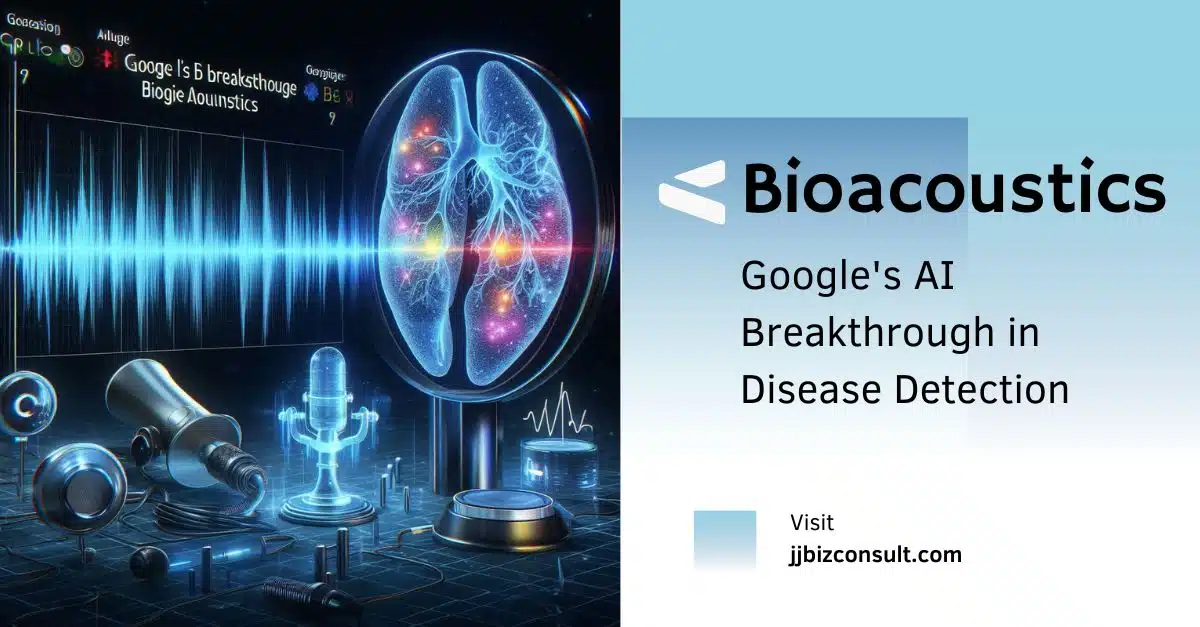
Bioacoustics: Google's AI Breakthrough in Disease Detection
Bioacoustics: Google is at the forefront of a medical revolution with its groundbreaking AI model that can diagnose diseases based on sound signals. This innovative technology, known as Health Acoustic Representations (HeAR), has the potential to transform healthcare, especially in regions with limited access to advanced medical facilities.
Harnessing the Power of Sound
HeAR is a bioacoustic foundation model trained on a massive dataset of audio clips, including cough sounds. By analyzing these sound signals, the AI can identify patterns that may indicate underlying health conditions, such as tuberculosis (TB).
Collaboration with Salcit Technologies

Google has partnered with Salcit Technologies, an Indian respiratory healthcare AI startup, to apply HeAR to the early detection of TB. Swaasa, Salcit’s AI-powered lung health assessment tool, is being enhanced with HeAR’s capabilities to analyze cough sounds and identify potential signs of TB.
Addressing the Global TB Crisis
The World Health Organization estimates that three to four million cases of TB go unreported annually, leading to a devastating mortality rate. HeAR offers a promising solution to this global health crisis by enabling early detection and diagnosis, even in remote or resource-limited areas.
The Potential of AI in Healthcare
Google’s work on HeAR is just one example of the growing potential of AI in healthcare. Researchers worldwide are exploring the applications of AI in diagnosing a wide range of illnesses, from chronic diseases to rare conditions.
As AI technology continues to advance, we can expect to see even more innovative and effective solutions for early detection and diagnosis, improving healthcare outcomes for millions of people around the world.
What other diseases can be detected using bioacoustics?

Bioacoustics, the study of sound in biological systems, is being increasingly used to detect a variety of diseases. Here are some notable examples:
- Tuberculosis (TB): AI models can analyze cough sounds to detect TB, as seen with Google’s HeAR technology1.
- COVID-19: Researchers have developed AI systems that can identify COVID-19 by analyzing cough and breathing sounds2.
- Chronic Obstructive Pulmonary Disease (COPD): Similar to TB, COPD can be detected through the analysis of cough and breathing patterns3.
- Parkinson’s Disease: Changes in voice and speech patterns can be indicative of Parkinson’s, and bioacoustic methods are being used to detect these changes1.
- Attention Deficit Disorder (ADD): Pilot studies have shown that bioacoustic methods can help in identifying ADD by analyzing specific sound patterns4.
- Post Traumatic Stress Disorder (PTSD): Bioacoustic analysis is also being explored for detecting PTSD through changes in vocal patterns4.
The potential for bioacoustics in healthcare is vast, and as AI technology continues to advance, we can expect even more innovative applications in disease detection.
Challenges for Bioacoustics
Bioacoustics, while it’s super cool, has some hurdles to jump over:
- Data Deluge: Oh boy, the amount of audio stuff we get is like trying to drink from a firehose. We need some fancy tech and a lot of computer muscle to deal with it all.
- Nature’s Noisy Nightclub: Sometimes the background sounds are like trying to have a convo at a rock concert. Urban areas and loud nature spots make it tough to hear the critters clearly.
- Gear Gremlins: The mics and recorders can act up, especially when the weather’s a grump. Keeping them happy and running is key for solid data.
- Who’s Who in the Zoo: Figuring out which animal is making which noise can be tricky. Some sound-alikes make it hard to pinpoint who’s who.
- Data Puzzle: Once we’ve got the sounds, we’ve got to make sense of them. That’s where the brainiacs with their clever algorithms come in, to tell us what’s really going on with animal health and nature’s gossip.
- The Ethics Shuffle: Recording sounds can be like playing hide and seek with people’s privacy. We’ve gotta be super respectful of that.
But hey, don’t worry, because AI and machine learning are like the dynamic duo swooping in to save the day. They’re helping us tackle these issues so bioacoustics can keep being amazing for both checking on animals’ health and keeping tabs on the environment..
Recent breakthroughs in Bioacoustics
There have been some super cool things happening in bioacoustics lately, guys:
- So, these peeps at UMass Amherst came up with some machine learning stuff that can tell which bug is making what noise. It’s like Shazam for insects, but for science! It’s pretty big because it helps us keep an eye on how many bugs we have and if our planet is doing okay1.
- And get this, we can now keep tabs on ecosystems in real time! Scientists are using these cheap digital recorders to listen in on the animal jam sessions in the forest and other places animals live. This way, they can figure out what’s going on with all the species and if the climate is messing with them2.
- Deep learning is like the brainiacs of AI, and it’s getting better at listening too. These fancy algorithms, like CNNs and CRNNs, are helping us understand animal chats better. It’s like decoding the animal language in those big nature sound libraries3.
- Bioacoustics is also being talked about as a way to count how many different species we have without messing with them. It’s like a non-invasive headcount for animals, which is really helpful in places we can’t easily get to or where animals are really shy4.
All of this is making bioacoustics, like, a superhero in both checking out the environment and helping with health stuff. It’s pretty sweet!
Google’s Gemini Flash 1.5: Blazing Speed and Boosted Context Put AI at Your Fingertips
Cybercab Revolution: Tesla’s RoboTaxi Set to Disrupt Ride-Sharing





